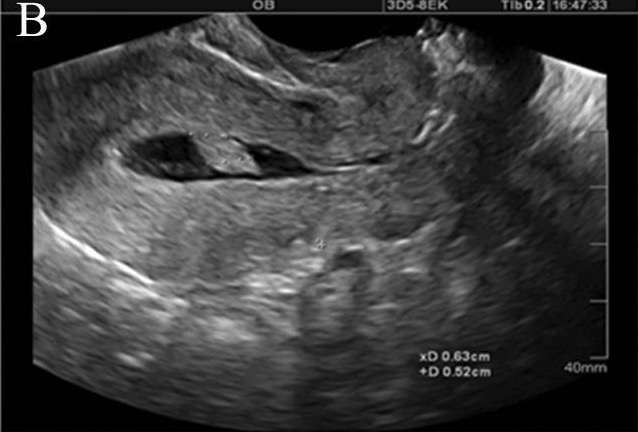Playlist
Show Playlist
Hide Playlist
AUB: Causes by Age Groups
-
Slides AbnormalUterineBleeding ReproductiveEndocrinology.pdf
-
Download Lecture Overview
00:00 Let’s now review AUB by age. So in the neonatal period, mom usually calls the pediatrician frantically because there will be blood in a female baby’s diaper. Why would that be? I’m going to give you a chance to answer that. We’ll I’ll tell you why. It could be estrogen withdrawal. So, mom has lots of estrogen that’s circulating, then the baby is born, the umbilical cord is cut, and baby no longer has access to the high levels of estrogen from the placenta and from mom and so that baby will have a withdrawal bleed, which is normally what happens in a period. So seeing blood in baby’s diaper is actually a good sign that at least her outflow tract, her uterus and her vagina are normal. Let’s talk now about the neonatal period. Babies and toddlers who were able to insert things into their ears or into their mouth can also insert things into their vagina which actually cause vaginitis and therefore bleeding. Babies can occasionally have adenomyosis which causes some bleeding but we should never forget to be suspicious of sexual abuse, which is very common between 1 and 5 children have had some type of sexual abuse. Also, vulvovaginitis from sexually transmitted infections can actually present as bleeding. Cancer, unfortunately, can happen in young girls and the sarcoma botryoides here, which is displayed, can kill little girls and cause AUB as well. Precocious puberty, which happens usually before the age of 6, is always pathologic and needs to be evaluated and investigated. Let’s review AUB in the early postmenarchal stage. Remember these girls have just gone through period, the average age of menarche being 12 years old, and they can have an immature hypothalamic pituitary ovarian access and what this means is that the hypothalamus, the pituitary, and the ovary are not quite in sync yet and so what happens is they have anovulatory cycles, which can lead to regular or sometimes missed periods or even heavy bleeding. Remember these young girls may be under a lot of stress. Stress to perform well in their academics or sports or to look a certain way, and sometimes this can lead to heavy bleeding. Don’t forget that the US has the highest pregnancy rate in the world and so this should be ruled out right away in these patients. And also, if they are sexually active, there’s always a possibility of sexually-transmitted infections causing endometritis that can actually cause abnormal uterine bleeding. Let’s now look in the older reproductive age woman. 02:55 So recall that we discussed PCOS or polycystic ovarian syndrome that can lead to a chronic anovulation and then heavy periods when they do occur. Pregnancy also needs to be ruled out in this group. These women also have the potential to have an endocrine disorder such as hypothyroidism that can lead to heavy bleeding. These women also tend to have structural causes such as polyps, fibroids, and adenomyosis. These older women can be on medications such as blood thinners or antipsychotics that can lead to AUB. Infection is also a cause in this age group. Sarcomas, while they are rare, can occur and can cause AUB. And don’t forget, we need to screen for coagulation disorders as well. In the perimenopause, these women are heading towards the final period. Usually, the average age in the US is 51 years old and as we head to the final menstrual cycle, you can have anovulation just as you did at the very beginning of menarche. These patients can also suffer from structural causes such as polyps, fibroids, and adenomyosis as well as cancer, which should not be forgotten. In the postmenopause, these women can actually have atrophy, which means thinning of the lining of their uterus and thinning of the vagina, which can actually cause bleeding. They can actually have cancer, which should be ruled out. Polyps, which are structural causes, especially if they have been on tamoxifen. Hormone replacement therapy, which we give to help with vasomotor symptoms, can actually cause bleeding and should still be evaluated even if they’re on hormone replacement therapy. And finally, we did discuss tamoxifen but just to recall your attention, it’s a selective estrogen receptor modulator or a serum for short and any serum can cause postmenopausal bleeding.
About the Lecture
The lecture AUB: Causes by Age Groups by Lynae Brayboy, MD is from the course Reproductive Endocrinology.
Included Quiz Questions
Which of the following can present in neonates as abnormal uterine bleeding and grape-like vesicles protruding through the vagina?
- Sarcoma botryoides
- Sexual abuse
- Foreign bodies
- Precocious puberty
- Estrogen withdrawal
A mother frantically comes to pediatrician complaining of blood in the diaper of her newborn baby girl. The mother claims to have recently hired a man as housekeeper and a maid since she is busy. What is the next step?
- Thorough examination to rule out sexual abuse
- Explain estrogen withdrawal is usually the cause
- Tell the mother that the baby might have cancer
- Tell the mother that the baby might have an infection of the female genital area
- Perform ultrasound for sarcoma botryoides
A 15-year-old girl complains that she has been having irregular periods every 2 months. She has not menstruated for about 3 months and comes to the doctor primarily for that reason. She refuses to give details on her sexual activity. What is the next step?
- Performing a pregnancy test
- Explain that she has hypothalamic pituitary axis immaturity causing delayed menstrual cycles
- Examine for cancer
- Explain that she has a sexually transmitted disease
- Explain that it's a result of excess stress
Which of the following is NOT a cause of abnormal uterine bleeding in a reproductive age group?
- Sarcoma botryroides
- Polyps
- Leiomyomas
- Pregnancy
- Infection
Customer reviews
5,0 of 5 stars
| 5 Stars |
|
5 |
| 4 Stars |
|
0 |
| 3 Stars |
|
0 |
| 2 Stars |
|
0 |
| 1 Star |
|
0 |




